安徽省省情翻译
- 格式:doc
- 大小:435.50 KB
- 文档页数:5
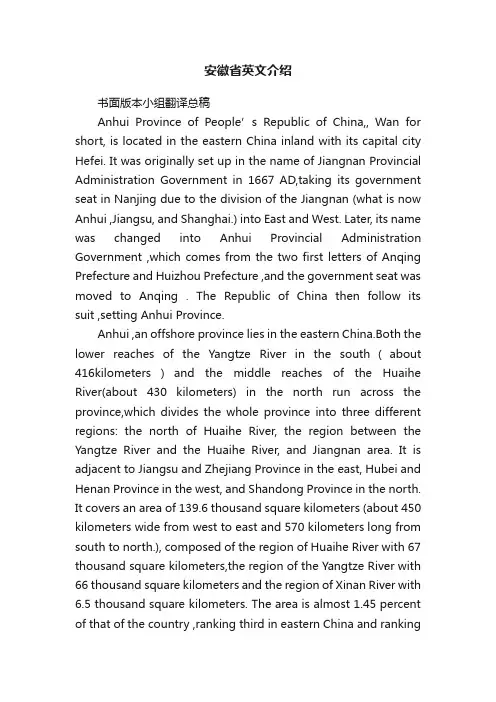
安徽省英文介绍书面版本小组翻译总稿Anhui Province of People’s Republic of China,, Wan for short, is located in the eastern China inland with its capital city Hefei. It was originally set up in the name of Jiangnan Provincial Administration Government in 1667 AD,taking its government seat in Nanjing due to the division of the Jiangnan (what is now Anhui ,Jiangsu, and Shanghai.) into East and West. Later, its name was changed into Anhui Provincial Administration Government ,which comes from the two first letters of Anqing Prefecture and Huizhou Prefecture ,and the government seat was moved to Anqing . The Republic of China then follow its suit ,setting Anhui Province.Anhui ,an offshore province lies in the eastern China.Both the lower reaches of the Yangtze River in the south(about 416kilometers)and the middle reaches of the Huaihe River(about 430 kilometers) in the north run across the province,which divides the whole province into three different regions: the north of Huaihe River, the region between the Yangtze River and the Huaihe River, and Jiangnan area. It is adjacent to Jiangsu and Zhejiang Province in the east, Hubei and Henan Province in the west, and Shandong Province in the north. It covers an area of 139.6 thousand square kilometers (about 450 kilometers wide from west to east and 570 kilometers long from south to north.), composed of the region of Huaihe River with 67 thousand square kilometers,the region of the Yangtze River with 66 thousand square kilometers and the region of Xinan River with 6.5 thousand square kilometers. The area is almost 1.45 percent of that of the country ,ranking third in eastern China and rankingtwenty-second in the whole country.Anhui Province is at longitude 114°54’--119°37’ east and 29°41’--34°38’ north latitude. It is located in the transitional area of warm temperate climate. Divided by the Huaihe River, the northern region of Anhui belongs to sub-humid warm temperate monsoon climate zone,and the southern part is subtropical monsoon climate. So the Anhui Province has a very temperate climate with abundant sunshine, evident monsoon climate and four distinct seasons.The topography and terrain of this province is various. The landscape is mainly made up of plain (31.3%), hill (29.5%),and lower mountain (31.2%),which are always in opposite arrangement, forming the diversity of landscape in this area. The lakes and marshes also take 8 percent of the whole landscape. The natural area can be divided into five different types: the Huaibei Plain, the Jianghuai Hill, the Dabieshan Mountain Area in the western part of Anhui , the Plain along the Yangtze River, and the Mountain Area in the southern part of Center-China.The culture of Anhui Province can be classified into three major kind:the culture of Anhui, the culture of the region between the Yangtze River and the Huaihe River, the culture of Zhongyuan . According to the sixth nationwide census in 2010, this province has reached a population of 68.62 million. The province tree is the Pinus taiwanensis, the province flower is Rhododendron anhweiense Wils and the province bird is cyanopica cyana. There are many magnificent mountain ranges in this province , including Mt.Dabieshan, Mt.Huangshan, Mt.Jiuhuashan, Mt.Tianzhushan. And the altitude of the highest peak in Mt.Huangshan can reach 1864.7 meters.Besides, it also has a great number of rivers and lakes. Chaohu, one of the fivelargest fresh lakes in China also lies in this province. With abundant resources and advanced agriculture,Anhui Province is a quite large aggregation of human life.。
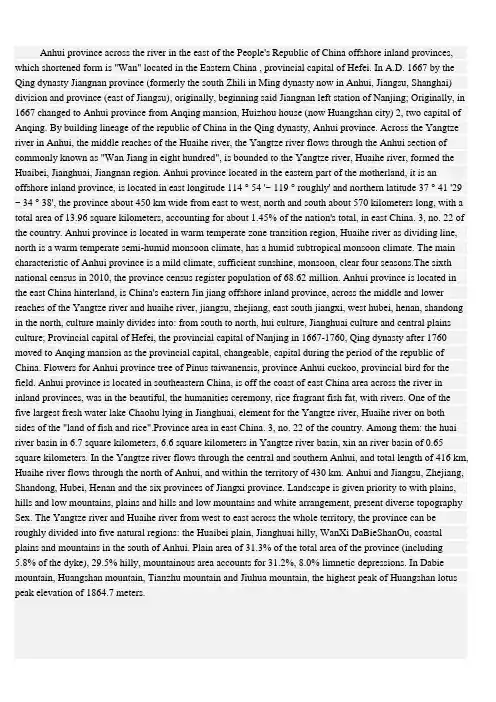
Anhui province across the river in the east of the People's Republic of China offshore inland provinces, which shortened form is "Wan" located in the Eastern China , provincial capital of Hefei. In A.D. 1667 by the Qing dynasty Jiangnan province (formerly the south Zhili in Ming dynasty now in Anhui, Jiangsu, Shanghai) division and province (east of Jiangsu), originally, beginning said Jiangnan left station of Nanjing; Originally, in 1667 changed to Anhui province from Anqing mansion, Huizhou house (now Huangshan city) 2, two capital of Anqing. By building lineage of the republic of China in the Qing dynasty, Anhui province. Across the Yangtze river in Anhui, the middle reaches of the Huaihe river, the Yangtze river flows through the Anhui section of commonly known as "Wan Jiang in eight hundred", is bounded to the Yangtze river, Huaihe river, formed the Huaibei, Jianghuai, Jiangnan region. Anhui province located in the eastern part of the motherland, it is an offshore inland province, is located in east longitude 114 ° 54 '~ 119 ° roughly' and northern latitude 37 ° 41 '29 ~ 34 ° 38', the province about 450 km wide from east to west, north and south about 570 kilometers long, with a total area of 13.96 square kilometers, accounting for about 1.45% of the nation's total, in east China. 3, no. 22 of the country. Anhui province is located in warm temperate zone transition region, Huaihe river as dividing line, north is a warm temperate semi-humid monsoon climate, has a humid subtropical monsoon climate. The main characteristic of Anhui province is a mild climate, sufficient sunshine, monsoon, clear four seasons.The sixth national census in 2010, the province census register population of 68.62 million. Anhui province is located in the east China hinterland, is China's eastern Jin jiang offshore inland province, across the middle and lower reaches of the Yangtze river and huaihe river, jiangsu, zhejiang, east south jiangxi, west hubei, henan, shandong in the north, culture mainly divides into: from south to north, hui culture, Jianghuai culture and central plains culture; Provincial capital of Hefei, the provincial capital of Nanjing in 1667-1760, Qing dynasty after 1760 moved to Anqing mansion as the provincial capital, changeable, capital during the period of the republic of China. Flowers for Anhui province tree of Pinus taiwanensis, province Anhui cuckoo, provincial bird for the field. Anhui province is located in southeastern China, is off the coast of east China area across the river in inland provinces, was in the beautiful, the humanities ceremony, rice fragrant fish fat, with rivers. One of the five largest fresh water lake Chaohu lying in Jianghuai, element for the Yangtze river, Huaihe river on both sides of the "land of fish and rice".Province area in east China. 3, no. 22 of the country. Among them: the huai river basin in 6.7 square kilometers, 6.6 square kilometers in Yangtze river basin, xin an river basin of 0.65 square kilometers. In the Yangtze river flows through the central and southern Anhui, and total length of 416 km, Huaihe river flows through the north of Anhui, and within the territory of 430 km. Anhui and Jiangsu, Zhejiang, Shandong, Hubei, Henan and the six provinces of Jiangxi province. Landscape is given priority to with plains, hills and low mountains, plains and hills and low mountains and white arrangement, present diverse topography Sex. The Yangtze river and Huaihe river from west to east across the whole territory, the province can be roughly divided into five natural regions: the Huaibei plain, Jianghuai hilly, WanXi DaBieShanOu, coastal plains and mountains in the south of Anhui. Plain area of 31.3% of the total area of the province (including5.8% of the dyke), 29.5% hilly, mountainous area accounts for 31.2%, 8.0% limnetic depressions. In Dabie mountain, Huangshan mountain, Tianzhu mountain and Jiuhua mountain, the highest peak of Huangshan lotus peak elevation of 1864.7 meters.安徽省,中华人民共和国东部跨江近海的内陆省份,简称"皖",位于华东地区,省会合肥市。

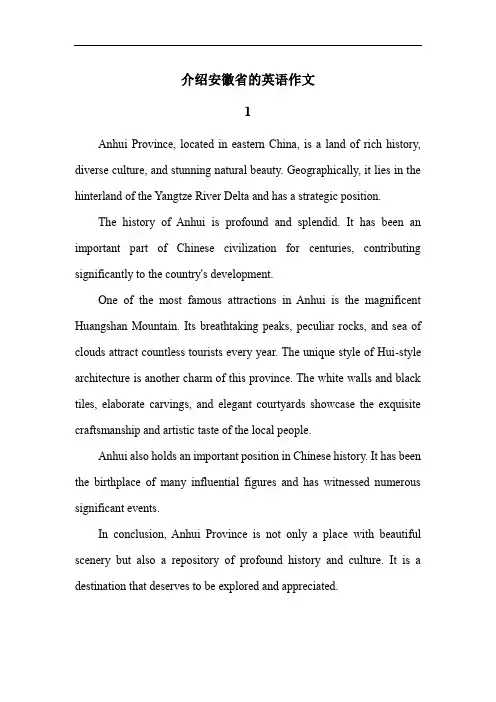
介绍安徽省的英语作文1Anhui Province, located in eastern China, is a land of rich history, diverse culture, and stunning natural beauty. Geographically, it lies in the hinterland of the Yangtze River Delta and has a strategic position.The history of Anhui is profound and splendid. It has been an important part of Chinese civilization for centuries, contributing significantly to the country's development.One of the most famous attractions in Anhui is the magnificent Huangshan Mountain. Its breathtaking peaks, peculiar rocks, and sea of clouds attract countless tourists every year. The unique style of Hui-style architecture is another charm of this province. The white walls and black tiles, elaborate carvings, and elegant courtyards showcase the exquisite craftsmanship and artistic taste of the local people.Anhui also holds an important position in Chinese history. It has been the birthplace of many influential figures and has witnessed numerous significant events.In conclusion, Anhui Province is not only a place with beautiful scenery but also a repository of profound history and culture. It is a destination that deserves to be explored and appreciated.Anhui Province, located in eastern China, is a land of rich history and diverse culture. It is a place that holds many treasures and attractions.The cuisine of Anhui is a delightful mix of flavors. The Stinky Mandarin Fish, with its unique aroma and tender texture, is a delicacy that leaves a lasting impression. And the Huainan Beef Soup, known for its rich broth and tender beef, warms the hearts and stomachs of people.When it comes to folk culture, the Huangmei Opera takes the spotlight. Its beautiful melodies and touching stories have been passed down through generations, captivating the hearts of both locals and visitors.The landscapes of Anhui are simply breathtaking. There are magnificent mountains, serene lakes, and charming villages. The ancient architecture, with its elegant designs and exquisite craftsmanship, tells the tales of the past.The people of Anhui are friendly and hardworking. Their traditions and customs are deeply rooted in the soil of this province, creating a sense of belonging and unity.In conclusion, Anhui Province is not only a place of natural beauty but also a home to a rich cultural heritage and delicious food. It is a province that deserves to be explored and appreciated.Anhui Province, located in eastern China, has witnessed remarkable economic development and remarkable achievements in technological innovation in recent years. The province has been actively promoting the development of emerging industries, which has greatly contributed to its economic growth.One of the significant emerging industries in Anhui is the new energy vehicle sector. With the support of government policies and continuous technological breakthroughs, many enterprises in Anhui have made great progress in the research and development and production of new energy vehicles. These vehicles are not only energy-efficient but also environmentally friendly, meeting the growing demand for sustainable transportation.The electronic information industry in Anhui has also flourished. High-tech enterprises have emerged one after another, specializing in the production of advanced electronic components and intelligent devices. Their products are widely used in various fields such as communication, healthcare, and industrial automation, demonstrating Anhui's strong technological strength in this area.In addition, the biopharmaceutical industry in Anhui has shown great potential. A number of research institutions and enterprises are engaged in the development and production of innovative drugs and medical devices,making important contributions to improving people's health and medical care.The economic development and technological innovation achievements of Anhui Province are inseparable from the efforts of the government, the input of enterprises, and the support of talents. The province continues to optimize the business environment, attract more investment and talent, and is expected to achieve even more remarkable results in the future.4Anhui Province, located in eastern China, is not only rich in natural resources but also boasts remarkable educational resources. The province is home to several prestigious universities that play a crucial role in its development.Among these, Anhui University stands out with its diverse range of academic disciplines and excellent teaching staff. It attracts students from all over the country, contributing to the cultural and intellectual exchange within the province. Another notable institution is Hefei University of Technology, renowned for its strong programs in engineering and technology. Graduates from this university have made significant contributions to the local industry, driving economic growth and technological innovation.These universities not only provide high-quality education but alsoconduct research in various fields. Their research findings have led to advancements in agriculture, manufacturing, and other key sectors, enhancing Anhui's competitiveness on the national stage. Moreover, they foster a spirit of entrepreneurship among students, resulting in the establishment of numerous startups that create job opportunities and stimulate economic vitality.In conclusion, the educational resources and renowned universities in Anhui Province are the driving force behind its progress and prosperity. They shape the future of the province by nurturing talented individuals who will continue to contribute to its growth and development for years to come.5Anhui Province, located in eastern China, is a land of breathtaking natural beauty. Among its many wonders, Chaohu stands out with its vast expanse and captivating charm. The lake's surface shimmers like a mirror under the sunlight, reflecting the surrounding lush mountains and greenery. The gentle breeze blowing across the water creates ripples that dance gracefully, adding a touch of vitality to the serene scene.Another gem is Jiuhua Mountain, which exudes a sacred and solemn atmosphere. Its peaks soar high into the clouds, creating a majestic silhouette against the sky. The ancient temples nestled among the mountains offer a sense of tranquility and spiritual connection. The sounds of bells and chanting monks echo through the valleys, inviting visitors toembark on a journey of inner peace and reflection.The natural landscapes of Anhui Province are not only a feast for the eyes but also a source of inspiration and rejuvenation for the soul. The harmonious blend of mountains, waters, and forests creates a symphony of nature that leaves a lasting impression on all who have the privilege to experience it. Whether it's the peaceful Chaohu or the sacred Jiuhua Mountain, Anhui Province is truly a haven of natural beauty waiting to be explored and cherished.。

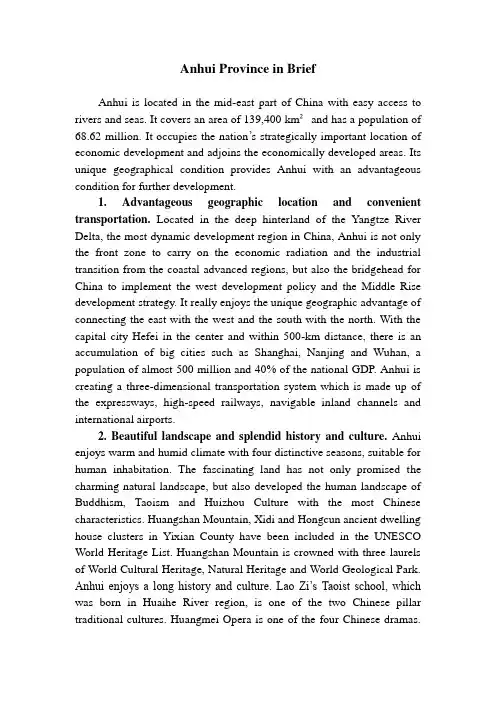
Anhui Province in BriefAnhui is located in the mid-east part of China with easy access to rivers and seas. It covers an area of 139,400 km²and has a population of 68.62 million. It occupies the nation’s strategically important location of economic development and adjoins the economically developed areas. Its unique geographical condition provides Anhui with an advantageous condition for further development.1. Advantageous geographic location and convenient transportation. Located in the deep hinterland of the Yangtze River Delta, the most dynamic development region in China, Anhui is not only the front zone to carry on the economic radiation and the industrial transition from the coastal advanced regions, but also the bridgehead for China to implement the west development policy and the Middle Rise development strategy. It really enjoys the unique geographic advantage of connecting the east with the west and the south with the north. With the capital city Hefei in the center and within 500-km distance, there is an accumulation of big cities such as Shanghai, Nanjing and Wuhan, a population of almost 500 million and 40% of the national GDP. Anhui is creating a three-dimensional transportation system which is made up of the expressways, high-speed railways, navigable inland channels and international airports.2. Beautiful landscape and splendid history and culture. Anhui enjoys warm and humid climate with four distinctive seasons, suitable for human inhabitation. The fascinating land has not only promised the charming natural landscape, but also developed the human landscape of Buddhism, Taoism and Huizhou Culture with the most Chinese characteristics. Huangshan Mountain, Xidi and Hongcun ancient dwelling house clusters in Yixian County have been included in the UNESCO World Heritage List. Huangshan Mountain is crowned with three laurels of World Cultural Heritage, Natural Heritage and World Geological Park. Anhui enjoys a long history and culture. Lao Zi’s Taoist school, which was born in Huaihe River region, is one of the two Chinese pillar traditional cultures. Huangmei Opera is one of the four Chinese dramas.The Flower-Drum dancing along the Huaihe River banks is honored with the Oriental Ballet. Anhui has produced many famous talents in different times and fields.3. Abundant natural resources and developed characteristic industries. Anhui is endowed with fertile land and plentiful species. It is one of China’s key production bases for agriculture, forestry and animal products. The three water systems of Yangtze River, Huaihe River and Xin’an River and one of the state five fresh water lakes, Chaohu Lake, have provided Anhui with plenty of water resources. Anhui also enjoys various and massive mineral resources, with 138 minerals having been discovered and the reserves of 11 minerals being the top ten. The sci-tech resources are also distinctively advantageous. There are more than 158 provincial-level or above scientific institutions, 110 colleges and universities, 4 national-level large scientific projects and 43 key provincial-level or ministerial-level laboratories. The provincial capital city Hefei is the only one technological innovation pioneer city in the country and a city with the most intensive large scientific projects only except Beijing. On the basis of the advantaged natural resources, sci-tech resources and human resources, Anhui is developing into the key nationwide energy resources and raw material base and the modern equipment, manufacture and hi-tech industry base.4. Superior investment environment and great development potential. The land price and the labor cost in Anhui are relatively cheap. The employment cost is less than 70% of that in the coastal area and the comprehensive commercial cost is only about a half of that in the coastal area. Anhui has always adopted the positive and incentive policy on the foreign investment. By means of the top-down efficiency revolution in government departments, it is to simplify the procedure of the examination and approval, strengthen the promotion of policies, create a kind of open, fair, high efficient and uncorrupted government affair environment for investors, and attract foreign investment by means of combined environment advantages.。
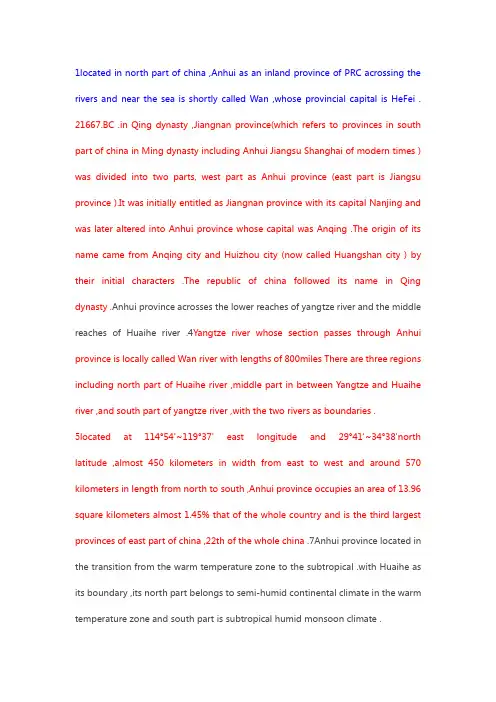
1located in north part of china ,Anhui as an inland province of PRC acrossing the rivers and near the sea is shortly called Wan ,whose provincial capital is HeFei . 21667.BC .in Qing dynasty ,Jiangnan province(which refers to provinces in south part of china in Ming dynasty including Anhui Jiangsu Shanghai of modern times ) was divided into two parts, west part as Anhui province (east part is Jiangsu province ).It was initially entitled as Jiangnan province with its capital Nanjing and was later altered into Anhui province whose capital was Anqing .The origin of its name came from Anqing city and Huizhou city (now called Huangshan city ) by their initial characters .The republic of china followed its name in Qing dynasty .Anhui province acrosses the lower reaches of yangtze river and the middle reaches of Huaihe river .4Yangtze river whose section passes through Anhui province is locally called Wan river with lengths of 800miles There are three regions including north part of Huaihe river ,middle part in between Yangtze and Huaihe river ,and south part of yangtze river ,with the two rivers as boundaries .5located at 114°54'~119°37' east longitude and 29°41'~34°38'north latitude ,almost 450 kilometers in width from east to west and around 570 kilometers in length from north to south ,Anhui province occupies an area of 13.96 square kilometers almost 1.45% that of the whole country and is the third largest provinces of east part of china ,22th of the whole china .7Anhui province located in the transition from the warm temperature zone to the subtropical .with Huaihe as its boundary ,its north part belongs to semi-humid continental climate in the warm temperature zone and south part is subtropical humid monsoon climate .8the main features of Anhui province in its climate is its warmth in temperature ,it's sufficient sunshine ,it's clear monsoonal character and it's four distinctive seasons .statics in 6th population census in 2010 suggested that there are68.420.000 people in Anhui province altogether . 9Located in central region of east part of china ,Anhui province neighbors Jiangsu and zhejiang provinces to its east part ,Jiangxi province to its south part ,links Hubei and Henan provinces to its west part ,Shandong province to its north part .As for its culture ,it can be separated into three parts from south to north as Huizhou culture, Yangtze and Huaihe culture, and middle land culture .Its capital is now located in Hefei city ,while in Qing dynasty from1667 to 1760 its capital was Nanjing province ,after that Anqing city took its place ,and in the period of the republic of china the capital changed for many times .12Its provincial tree is pines in huangshan ,its provincial flower is cuckoo of Anhui province and its provincial bird is cyanopica cyanadistinctive for its beautiful mountains and rivers ,its unfathomable cultures ,its thriving agriculture and numerous rivers.14Chaohu lake one of the five freshwater lakes lying acrossYangtze and Huaihe river is well known as the "homeland of rice and fish "in lower reaches of Yangtze river and two banks of Huaihe river .6.Its area is the third largest of East china and the 22th of the nation among which Huaihe River basin takes 67.000 square kilometers ,Yangtze river basin 66.000 square kilometers ,and xinganjiang basin 6.500 square kilometers .3Yangtze river ,the length of which flows past south central Anhui province is 416 kilometers ,and which flows through north Anhui is 430 kilometers .Neighboring Jiangsu province ,Zhejiang province ,linking Shandong province , Hubei province ,and connecting Henan province , Jiangxi province ,Anhui province possesses various of landforms especially plains ,hills ,and low mountains .10 With Yangtze river and Huaihe river flowing across from west to east ,Anhui province can be simply divided into five parts as Huaibei plain ,Jiang huai hilly area ,Dabieshan mountain area ,Plain along the river ,and Mountain area in south of Anhui province .plain 31.3% of the total area ,hills of 31.2% ,mountains of 31.2% and wet land of 8.0%.11there many mountains such as Dabie mountain,Jiuhua mountain and Tianzhu mountain ,the highest peaks rising 1864.7 meters above sea level is lotus peak in yellow mountain .。
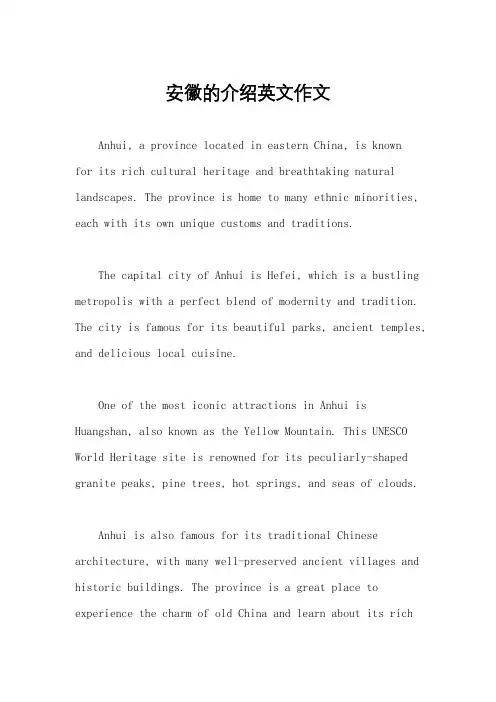
安徽的介绍英文作文Anhui, a province located in eastern China, is knownfor its rich cultural heritage and breathtaking natural landscapes. The province is home to many ethnic minorities, each with its own unique customs and traditions.The capital city of Anhui is Hefei, which is a bustling metropolis with a perfect blend of modernity and tradition. The city is famous for its beautiful parks, ancient temples, and delicious local cuisine.One of the most iconic attractions in Anhui is Huangshan, also known as the Yellow Mountain. This UNESCO World Heritage site is renowned for its peculiarly-shaped granite peaks, pine trees, hot springs, and seas of clouds.Anhui is also famous for its traditional Chinese architecture, with many well-preserved ancient villages and historic buildings. The province is a great place to experience the charm of old China and learn about its richhistory.The local cuisine in Anhui is a culinary delight, with dishes such as braised turtle, hairy tofu, and bamboo shoots. The province's food is known for its unique flavors and use of fresh, local ingredients.In addition to its cultural and historical attractions, Anhui is also a great destination for outdoor enthusiasts. The province offers a wide range of outdoor activities, including hiking, cycling, and birdwatching, thanks to its diverse natural landscapes.Overall, Anhui is a fascinating destination that offers a perfect blend of history, culture, and natural beauty. Whether you're interested in exploring ancient traditions, admiring stunning scenery, or indulging in delicious food, Anhui has something to offer for everyone.。
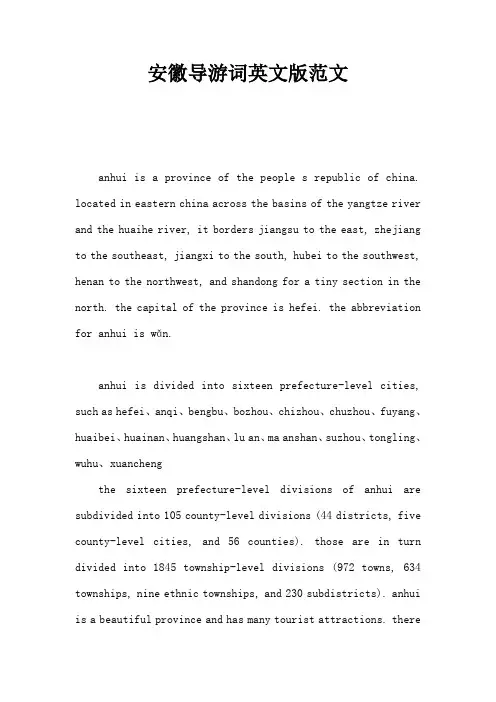
安徽导游词英文版范文anhui is a province of the people s republic of china. located in eastern china across the basins of the yangtze river and the huaihe river, it borders jiangsu to the east, zhejiang to the southeast, jiangxi to the south, hubei to the southwest, henan to the northwest, and shandong for a tiny section in the north. the capital of the province is hefei. the abbreviation for anhui is wǎn.anhui is divided into sixteen prefecture-level cities, such as hefei、anqi、bengbu、bozhou、chizhou、chuzhou、fuyang、huaibei、huainan、huangshan、lu an、ma anshan、suzhou、tongling、wuhu、xuanchengthe sixteen prefecture-level divisions of anhui are subdivided into 105 county-level divisions (44 districts, five county-level cities, and 56 counties). those are in turn divided into 1845 township-level divisions (972 towns, 634 townships, nine ethnic townships, and 230 subdistricts). anhui is a beautiful province and has many tourist attractions. thereare mang mountains in anhui, such as yellow mountain, jiu hua mountain, tianzhu mountain and so on. besideds, the largest lake in anhui and one of the five largest freshwater in china---chaohu is in the center of the province.the tea of anhui is also well-known in china, many famous chinese teas are from anhui, such as qimen black tea(祁门红茶),huangshan maofeng tea(黄山毛峰), liu’an gua pian(六安瓜片),anqing green tea(安庆绿茶) and so on.now i will emphasise on the introduction of yellow mountain , jiu huashan mountain, fangte happy world, and tianzhu mountain. yellow mountain, is located in the south of anhui, entire mountain area is approximately 1,200 square kilometers. it is famous for four unques, the guests-greeting pine, the hot spring, cloud sea and the strange stone. in the terms of the strang stone, there are various kinds, such as fly the stone(飞来石) , immortal play chess(仙人下棋) , the monkey view sea(猴子观海) , , the penglai three islands(蓬莱三岛) , and so on. besides, four unques , yellow mountain’s waterfall, sunrise and sunset glow, is also the magnificent sight .yellow mountain four seasons distinct: spring, the wild flower is brilliant; summer, everywhere flies the waterfall; autumn clear sky and fresh air, red leaves like rosy cloud;winter, the ice sculpture jade builds. yellow mountain is truly a good place for traveling.anhui another important travelling scenic area is the ancient villages in southern anhui. here are lovely jiangnan water amorous feelings and the local conditions and customs were very primitive simplicity.hongcun is a village in yi county, anhui province, near the southwest slope of yellow mountain. the village became a unesco world heritage site(世界文化遗产) in XX. because the scenery here is very beautiful,many people come to here to paint from nature.jiuhua mount is one of the sacred mountains of chinese buddhism. it is located in qingyang county in anhui province and is famous for its rich landscape and ancient temples. it has a sleeping buddha(睡佛). anhui fangte happy world is a major theme park, situated in wuhu, anhui province. it is the biggest theme park in china with a total area of 125,000,000 square metres. 1.5billion yuan was invested to built the park. there are 15 areas in the park including sunshine plaza, cosmo world, mysterious river valley, and kid’s world.tianzhu mountain is located in qianshan county, anqing city, tianzhu mountain has 45peaks which are 1000meters above sealevel. an hui is a beautiful place and is well worth traveling.。
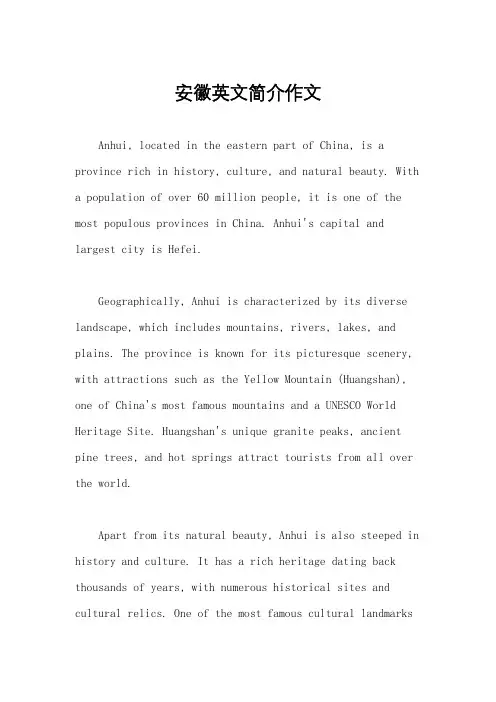
安徽英文简介作文Anhui, located in the eastern part of China, is a province rich in history, culture, and natural beauty. With a population of over 60 million people, it is one of the most populous provinces in China. Anhui's capital and largest city is Hefei.Geographically, Anhui is characterized by its diverse landscape, which includes mountains, rivers, lakes, and plains. The province is known for its picturesque scenery, with attractions such as the Yellow Mountain (Huangshan), one of China's most famous mountains and a UNESCO World Heritage Site. Huangshan's unique granite peaks, ancient pine trees, and hot springs attract tourists from all over the world.Apart from its natural beauty, Anhui is also steeped in history and culture. It has a rich heritage dating back thousands of years, with numerous historical sites and cultural relics. One of the most famous cultural landmarksin Anhui is the ancient village of Hongcun, another UNESCO World Heritage Site. Hongcun is renowned for its well-preserved traditional architecture, including elegant courtyard homes and intricate wood carvings.Anhui is also known for its distinctive cuisine, which is characterized by its use of local ingredients and traditional cooking methods. One of the most famous dishes from Anhui is "Braised Yellow Croaker," which features tender fish cooked in a savory sauce made from soy sauce, ginger, and other seasonings. Another popular dish is "Stinky Mandarin Fish," a spicy and aromatic fish dish that is a favorite among locals.In addition to its cultural and culinary attractions, Anhui is also home to a thriving economy, with industries ranging from manufacturing and agriculture to technology and finance. Hefei, the provincial capital, is a major industrial hub and a center for research and development, with several universities and research institutes located in the city.Overall, Anhui is a province of great diversity and vitality, with a rich cultural heritage, stunning natural landscapes, and a thriving economy. Whether you are interested in history, culture, or outdoor adventure, Anhui has something to offer for everyone.。

英语作文模板安徽Anhui Province。
Anhui, a province located in the eastern part of China, is known for its rich history, beautiful landscapes, and unique culture. With a population of over 60 million people, Anhui is one of the most populous provinces in China. The province is bordered by Jiangsu to the east, Zhejiang to the southeast, Jiangxi to the south, Hubei to the southwest, Henan to the northwest, and Shandong for a brief section in the north.One of the most famous attractions in Anhui is Huangshan, or Yellow Mountain. Known for its breathtaking scenery, Huangshan is a UNESCO World Heritage site and has inspired countless poets, painters, and photographers throughout history. The mountain is famous for its "four wonders" – oddly-shaped pines, grotesque rock formations, seas of clouds, and hot springs. Visitors can hike up the mountain to enjoy the stunning views or take a cable car for a more leisurely experience. The area surrounding Huangshan is also home to several ancient villages, such as Hongcun and Xidi, which are well-preserved examples of traditional Anhui architecture.Apart from Huangshan, Anhui is also home to several other natural and cultural attractions. The ancient city of Hefei, the capital of Anhui, is a blend of modern development and historical sites. The city's most famous attraction is the Memorial Temple of Lord Bao, a well-preserved temple dedicated to Bao Zheng, a famous official in ancient China known for his honesty and uprightness. Another popular destination is Jiuhua Mountain, one of the four sacred mountains of Chinese Buddhism. With its numerous temples and monasteries, Jiuhua Mountain is a place of pilgrimage for Buddhists from all over the world.Anhui's cuisine is also worth mentioning. The province is famous for its Huizhou cuisine, which is known for its use of wild herbs, bamboo shoots, and river fish. Huizhou cuisine is characterized by its delicate preparation and presentation, and it has a long history dating back to the Ming and Qing dynasties. Some popular dishes include StinkyMandarin Fish, Bamboo Shoots with Pork, and Li Hongzhang Hotchpotch. Visitors to Anhui should not miss the opportunity to try these unique and delicious dishes.In addition to its natural beauty and cultural heritage, Anhui is also an important economic and industrial hub in China. The province is known for its production of rice, wheat, tea, and other agricultural products. It is also a major producer of coal, steel, and chemicals. Anhui's economy has been growing rapidly in recent years, and the province has become an important center for manufacturing and technology.In conclusion, Anhui is a province with a rich history, stunning natural landscapes, and a unique cultural heritage. From the majestic peaks of Huangshan to the ancient villages of Hongcun and Xidi, there is no shortage of things to see and do in this beautiful province. Whether you are interested in history, nature, or cuisine, Anhui has something to offer for everyone. A visit to Anhui is sure to be an unforgettable experience.。
介绍安徽英语作文Anhui Province, located in the eastern part of China, is a region rich in history and culture. Here is an English composition that introduces Anhui:Anhui: A Treasure Trove of Culture and SceneryAnhui, with its capital city Hefei, is a province that offers a blend of natural beauty and historical significance. It is known for its picturesque landscapes, ancient villages, and vibrant cultural heritage.The province is home to the Yellow Mountains (Huangshan), a UNESCO World Heritage site that attracts tourists from around the globe. These mountains are renowned for their peculiarly shaped granite peaks, evergreen trees, hot springs, and views of the clouds from above. The Yellow Mountains are not only a paradise for hikers but also an inspiration for artists and poets.Another highlight of Anhui is the ancient village of Xidi and the nearby Hongcun, which are also recognized by UNESCO for their cultural value. These villages are well-preserved examples of traditional Chinese architecture, with white walls, black tiles, and intricate wood carvings that reflect the region's rich history.Anhui is also a province of great culinary traditions. Its cuisine, known as "Hui Cuisine," is famous for its use of wild herbs, bamboo shoots, and mushrooms, as well as its distinctive flavors that combine sweetness and sourness. A visit to Anhui would not be complete without tasting itslocal dishes such as "Beggar's Chicken" and "Smoked Tea Duck."Moreover, Anhui has a strong connection to the art of calligraphy and ink painting. The province has produced many renowned calligraphers and painters throughout Chinese history, making it a cultural hub for the arts.Lastly, the people of Anhui are known for their warm hospitality and traditional values. They take pride in their customs and are eager to share their culture with visitors.In conclusion, Anhui Province is a place where the past and present harmoniously coexist. Whether you are a lover of nature, history, art, or cuisine, Anhui has something tooffer everyone. It is a destination that invites you to explore its treasures and experience the essence of Chinese culture.This composition provides a brief introduction to Anhui, highlighting its natural wonders, cultural heritage, cuisine, and the warmth of its people. It is suitable for students learning English who wish to write about Chinese provinces.。
介绍安徽的作文英语Anhui, a province in the eastern part of China, is a region steeped in history, culture, and natural beauty. Known for its rich heritage and scenic landscapes, Anhui offers a unique blend of traditional and modern China.Geography and Climate:Anhui is located in the Yangtze River Delta and is bordered by Jiangsu, Zhejiang, Jiangxi, Hubei, Henan, and Shandong provinces. The province features a diverse topography, including the fertile plains of the Yangtze River basin, the rolling hills of the Huai River valley, and the majestic Huangshan (Yellow Mountain) range. The climate is characterized by a typical subtropical monsoon, with hot, humid summers and cool, dry winters.Historical Significance:Anhui has a long and storied history that dates back to the Neolithic era. It was a cradle of Chinese civilization and has been home to many dynasties and significant historical events. The province is particularly known for the Anhui School of Chinese painting and the Huizhou merchants, who played a crucial role in the development of China's economy during the Ming and Qing dynasties.Cultural Attractions:The province is a treasure trove for those interested in Chinese culture. The ancient villages of Xidi and Hongcun,with their well-preserved traditional architecture, are UNESCO World Heritage Sites. Anhui is also famous for its Anhui Opera, known for its unique singing style and acrobatic performances.Natural Wonders:The Huangshan Mountain, often referred to as the "Number One Miraculous Mountain" in China, is a must-see destination.With its peculiarly shaped granite peaks, evergreen trees,and views of the clouds from above, it is a breathtaking experience. The mountain is also renowned for its hot springs, which are believed to have therapeutic properties.Economic Development:In recent years, Anhui has experienced rapid economic growth, largely due to its thriving manufacturing and technology sectors. The province is also a significant agricultural producer, known for its tea, particularly the famous Huangshan Maofeng and Keemun black tea.Cuisine:Anhui cuisine, also known as Hui cuisine, is one of the eight great culinary traditions of China. It is characterized byits use of wild game, bamboo shoots, and a variety of freshwater fish from the region's rivers and lakes. Dishesare often seasoned with soy sauce, sugar, and vinegar,resulting in a harmonious balance of flavors.In conclusion, Anhui Province is a fascinating destinationthat offers a deep dive into China's past and present. Fromits historical landmarks to its natural wonders, Anhui is aplace where visitors can experience the authentic spirit of China.。
Anhui is a province located in the eastern part of China,boasting a rich history and a vibrant culture.Here is an introduction to this beautiful region:Geography and Climate:Anhui is situated along the middle and lower reaches of the Yangtze River,with its capital being Hefei.The province enjoys a subtropical monsoon climate,characterized by distinct seasons,abundant rainfall,and moderate temperatures.This climate is conducive to the growth of a wide variety of crops and contributes to the provinces rich agricultural output.Historical Significance:With a history that dates back thousands of years,Anhui has been an integral part of Chinese civilization.It is home to numerous historical sites,including the ancient city of Jixi,which is known for its wellpreserved architecture and cultural relics.Cultural Heritage:Anhui is renowned for its cultural heritage,particularly its traditional arts and crafts. Huangshan,a city within the province,is famous for its inkstone production,which is considered one of the Four Treasures of the Study in Chinese culture.Additionally,the province is known for its Anhui opera,a form of traditional Chinese theater with a unique style and performance techniques.Natural Wonders:The province is blessed with stunning natural landscapes.The Huangshan Mountain,also known as the Yellow Mountain,is one of Chinas most famous scenic spots,famous for its peculiarly shaped pines,grotesque rocks,hot springs,and a sea of clouds.It is a UNESCO World Heritage Site and a popular destination for tourists and photographers alike.Economic Development:Anhui has made significant strides in economic development,with a focus on industries such as manufacturing,agriculture,and tourism.The province is also investing in modern infrastructure to support its growing economy.Cuisine:Anhui cuisine,also known as Hui cuisine,is one of the eight great culinary traditions of China.It is known for its light flavors,emphasis on the freshness of ingredients,and the use of wild herbs and edible flowers.Dishes like Beggars Chicken and Smelly Tofu are famous beyond the provinces borders.Education:Anhui is home to several prestigious educational institutions,including the University of Science and Technology of China,which is one of the top research universities in the country.Festivals and Celebrations:The province celebrates various traditional festivals,such as the Chinese New Year and the MidAutumn Festival,with unique local customs and practices.These celebrations often involve family gatherings,feasting,and various cultural performances.In conclusion,Anhui Province is a region of China that offers a rich tapestry of natural beauty,historical significance,and cultural diversity.Whether you are interested in exploring ancient cities,enjoying the great outdoors,or experiencing traditional Chinese culture,Anhui has something to offer for everyone.。
介绍安徽的英语作文初中An Introduction to AnhuiAnhui is a beautiful province located in eastern China. With a rich history, stunning natural landscapes, and diverse cultural heritage, it is a popular destination for tourists and a fascinating place to learn about Chinese history and culture.Anhui is known for its picturesque scenery, with famous attractions such as Huangshan Mountain, a UNESCO World Heritage site known for its unique granite peaks, ancient pine trees, hot springs, and breathtaking views. Visitors can hike the mountain's trails, visit ancient temples and villages, and experience the natural beauty that has inspired poets and artists for centuries.In addition to its natural beauty, Anhui is a place with a deep cultural heritage. The province is home to the ancient city of Hefei, which has a history dating back over 2,000 years. Visitors can explore historic sites such as the Hefei Old Town, Anhui Provincial Museum, and Xiaoyaojin Park, which showcase the rich history and traditional culture of Anhui.Anhui is also famous for its traditional Chinese cuisine, such as Anhui cuisine, known for its use of fresh, seasonal ingredientsand unique cooking techniques. Popular dishes include Beggar's Chicken, Stinky Mandarin Fish, and Li Hongzhang Mutton. Food lovers will enjoy sampling the local delicacies and experiencing the flavors of Anhui's culinary tradition.Overall, Anhui is a province with a lot to offer for visitors looking to explore China's rich history and culture, experience stunning natural landscapes, and enjoy delicious cuisine. Whether you are interested in hiking, sightseeing, or sampling the local cuisine, Anhui has something for everyone to enjoy. Plan your trip to Anhui today and discover all that this fascinating province has to offer.。
安徽省情翻译(纸媒版)Anhui province,located in the eastern region of China,is an inland province.It is called “皖”(wan) for short,with Heifei as its capital city.The province of Anhui was formed in the 17th century.In 1645,the ruler of the Qing Dynasty(1636-1911)established Jiangnan Province(now Anhui,Jiangsu and Shanghai),whose predecessor was Nanzhili in its previous Ming Dynasty(1368-1644).At that time,Nanjing was made its capital city.Then in 1661,Jiangnan Province was divided into two parts,one of which was called “Jiangnan Left Administrative Commissioner’s Office”.In 1667,it was renamed to “Anhui Administrative Commissioner’s Office”.In 1760,the capital city moved to Anqing(a city the southwest of Anhui).Later ,Public of China(1912-1949) established Anhui Province on the basis of Qing Dynasty.The name of Anhui derives from the acronym of Anqing Prefecture and Huizhou Prefecture(now Huangshan City in south Anhui).Situated between east longitude 114°54′and 119°37′,north latitude 29°41′and 34°38′N, it has a total area of 139,600 km²,with a width of 450 km and a length of 570 km. It accounts for 1.45%of the total area of China, ranking the 3rd in East China, the 22nd in China. As an inland province, it borders Jiangsu and Zhejiang to the east, Jiangxi to the south, Hubei and Henan to the west, and Shandong to the north. The Yangtze River and Huaihe River cross through Anhui in the south and the north, dividing it to three major districts: Huaibei, Jianghuai and Jiangnan.Anhui is in the transitional region of the warm temperature zone, with Huaihe River as its boundry, the north part of which belongs to the semi-humid monsoonal climate, while the north the sub-tropical humid monsoonal climate. The mild weather, abundant sunshine, distinctive four seasons and monsoon are the main features of Anhui.The landform of Anhui shows great variety. Plains, hills and low mountains are the major forms which distribute in an inter-phase order. The area of plain accounts for 31.3%of the area of the whole province(including 5.8%of polder area),and hills 29.5%,mountains 31.2%,lakes and marshes 8.0%.With the Yangtze River and Huaihe River crossing Anhui from west to east, the province is separated into five natural regions: Huaibei Plain, Jianghuai Hilly area, Wanxi Dabie Mountainous area, Yanjiang Plain and Wannan Mountainous area.Anhui is famous for its picturesque mountains and rivers. Huangshan Mountain, Jiuhua Mountain, Tianzhu Mountain are the well-known mountains. The highest peak is the Lotus Peak(part of Huangshan),which has an altitude of 1864.7m.The Yangtze River finds its way through south Anhui, stretching 416km in this region and Huaihe River is in the north, stretching about 430km.Chaohu Lake, one of the five largest fresh lakes, lying in the center of the province, is an abundant place along the two rivers. Apart from the natural masterpiece, Anhui is also famous for its human landscape. It’s a densely populated province, with a population of about 68.52 million in 2010.Prosperous culture is another feature of Anhui, including Hui Culture, Jianghuai Culture and Zhongyuan Culture. The symbolic tree of Anhui is the Pinus Taiwanensis, which embodies the spirit of perseverance of Anhui people,and thesymbolic flower is Rhododendron anhweiense Wils ,the bird is cranopica cyana. Anhui Province, with its brilliant scenery, gathering of talents, rich natural resources and densely covered rivers, deserves your visit.翻译过程记录:源语:汉语译入语:英语原文本主题:安徽省省情介绍原文本的主要内容:从地理位置,历史沿革,气候人文,地形地貌等方面介绍安徽省原文本类型:安徽省政府网站上关于安徽省的介绍,属于旅游文本预计的译文读者:希望了解安徽省信息的外国读者译文的功能:给希望了解安徽省的外国读者提供更多更准确的信息准备过程:1.首先分析原文文本,发现原文组织混乱,很多信息出现了重复,并且每一段的信息不清晰,各方面都有覆盖。
比如在地理位置的描述中,“临江近海的内陆省份”这一信息就重复了四次;此外各段比较分裂,没有连贯和衔接。
我查询了安徽省政府网站,现在的省情介绍是经过修改的,各方面都比2013年版本的有所改进,每段主题鲜明,条理清晰。
截图如下:2.所以在分析文本和对照改进版本的介绍之后,我将原文信息进行了整合重组,分成以下五个部分:Para1:介绍安徽省的总体方位及历史沿革Para2:具体介绍安徽省的地理位置信息Para3:简单介绍安徽省的气候特征Para4:介绍安徽省的地形地貌特征Para5:介绍安徽省的山河湖泊以及人文特征Para6:用一两句话总括(原文中山河秀丽等四字成语)3.对原文中很多重复信息的删除,以及对有些信息的筛选与保留。
比如,“临江近海”中的“近海”我选择不翻,从安徽省地图来看,虽然距离东海较近,但不是直接临近,而且原文也说了它是内陆省份,所以如果加上“近海”感觉会有矛盾。
其次,对于“八百里皖江”我也选择不翻译,我觉得这个信息放在安徽省情介绍中不是重要信息,而且外国读者并不需要知道这一名称;还有淮河长江和新安江流域面积这一信息我也删去了,同样也是因为信息的不重要性。
4.在读原文第一段历史信息是,发现有两个一样的年份,但却发生了不同的事件,带着疑问我对安徽省的历史信息做了更加具体的查询,发现第二个年代出现错误,正确的是1760年改为安徽布政使而非1667年。
具体信息如下:说起“安徽省”就不能不提及“江南省”,“江南省”设于公元1645年(清顺治二年),省府驻地江宁(即今南京)。
清江南省的前身是明朝的“南直隶省”。
“江南省”的所辖范围大致相当于今天的江苏省、上海市和安徽省。
公元1661年(清顺治十八年),清廷将江南省一分为二,分为:“江南右布政使司”(治所苏州)和“江南左布政使司”(治所江宁)。